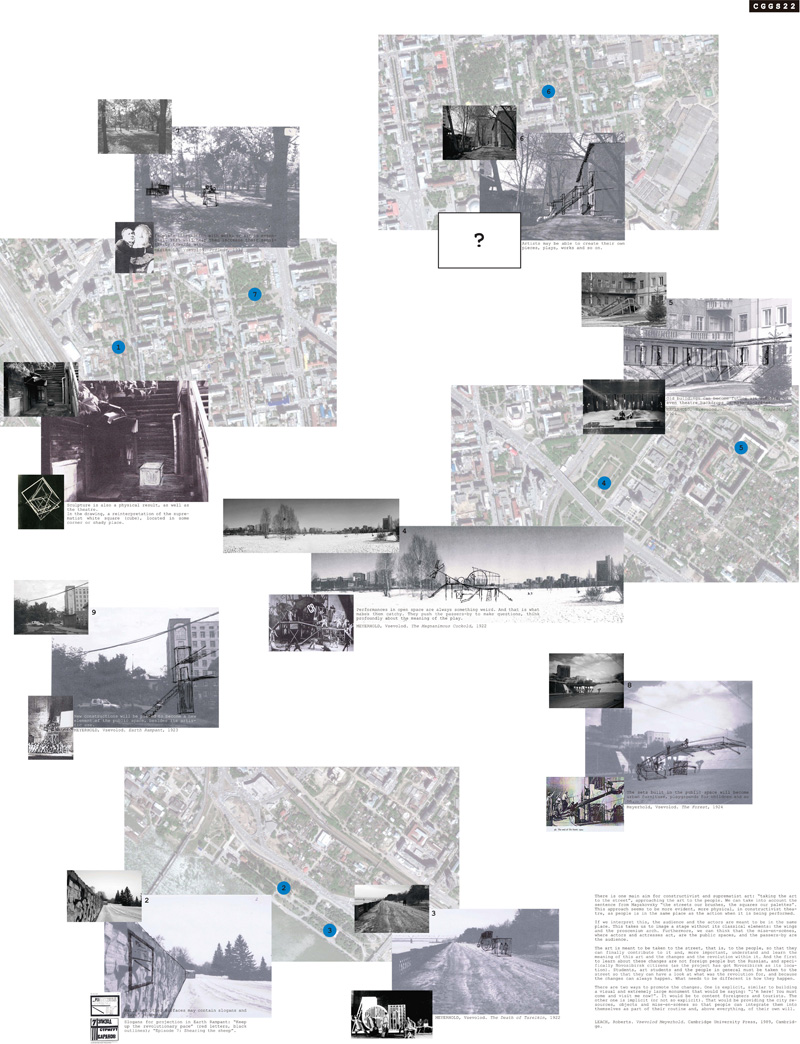Улицы — наши кисти, площади — наши палитры / The streets our brushes, the squares our palettes
Улицы — наши кисти, площади — наши палитры
Есть одна главная цель искусства конструктивизма и супрематизма: «вывести искусство на улицу», довести искусство до народа. Мы берём у Маяковского такое предложение: «улицы — наши кисти, площади - наши палитры». Этот подход выглядит более очевидным, более физическим в конструктивистском театре, когда люди располагаются там же, где происходит действие.
Если использовать этот принцип, то аудитория и актёры должны находиться в одном пространстве. Это позволяет нам представить сцену без классических элементов, крыльев и арок авансцены. Более того, мы можем представить, что мизансцены, в которых играют актёры и актрисы - это общественные места, а прохожие — аудитория.
Искусство должно быть на улице, т.е. быть ближе к людям, чтобы они могли внести свой вклад и, что ещё более важно, понять и использовать посыл искусства, посыл изменений и революций. И первыми, кто должен понять это, должны быть не иностранцы, а русские, более того, новосибирцы (т.к. проект направлен на Новосибирск). Студенты, студенты художественных училищ и люди вообще должны выйти на улицу, чтобы увидеть, для чего делалась революция, которая может произойти в любое время. Что нужно изменить — это то, как революции происходят.
Есть два способа способствовать изменениям. Первый- явный, похожий на строительство видимого и очень большого памятника, который как бы говорит: «Я здесь! Вы должны пойти и посмотреть на меня сейчас!» Это привлечёт иностранцев и туристов. Другой — неявный (или не такой явный). Он означает предоставление городских ресурсов, объектов и мизансцен, чтобы люди могли связать их с собой, сделать частью своей жизни и, более того, сделать это по своей воле.
1. Скульптура — это тоже физический результат, так же как и театр. На рисунке интерпретация супрематического белого квадрата (куба), расположенного в каком-либо углу или тёмном месте.
2. Стены и другие плоскости могут содержать призывы и плакаты пьес.
3. МЕЙЕРХОЛЬД, Всеволод. Смерть Тарелкина, 1922
4. Спектакли на открытых сценах всегда немного своеобразны. Это и делает их привлекательными. Они заставляют прохожих задавать вопросы, задумываться о смысле пьесы. МЕЙЕРХОЛЬД, Всеволод. Великодушный рогоносец, 1922.
5. Сцены, построенные в общественных местах станут городским пейзажем, детскими площадками и т.д. МЕЙЕРХОЛЬД, Всеволод. Лес, 1924
6. Старые здания могут стать будущими художественными школами или даже подмостками и сценами театров. МЕЙЕРХОЛЬД, Всеволод. Ревизор, 1926
7. Самое главное — взаимодействие людей с образцами искусства. Это позволяет лучше воспринимать искусство. МЕЙЕРХОЛЬД, Всеволод. Вступление, 1933
The streets our brushes, the squares our palettes
There is one main aim for constructivist and suprematist art: “taking the art to the street”, approaching the art to the people. We can take into account the sentence from Mayakovsky “the streets our brushes, the squares our palettes”. This approach seems to be more evident, more physical, in constructivist theatre, as people is in the same place as the action when it is being performed.
If we interpret this, the audience and the actors are meant to be in the same place. This takes us to image a stage without its classical elements: the wings and the proscenium arch. Furthermore, we can think that the mise-en-scиnes, where actors and actresses act, are the public spaces, and the passers-by are the audience.
The art is meant to be taken to the street, that is, to the people, so that they can finally contribute to it and, more important, understand and learn the meaning of this art and the changes and the revolution within it. And the first to learn about these changes are not foreign people but the Russian, and specifically Novosibirsk citizens (as the project has got Novosibirsk as its location). Students, art students and the people in general must be taken to the street so that they can have a look at what was the revolution for, and because the changes can always happen. What needs to be different is how they happen.
There are two ways to promote the changes. One is explicit, similar to building a visual and extremely large monument that would be saying: “I'm here! You must come and visit me now!”. It would be to content foreigners and tourists. The other one is implicit (or not so explicit). That would be providing the city resources, objects and mise-en-scиnes so that people can integrate them into themselves as part of their routine and, above everything, of their own will.
1. Sculpture is also a physical result, as well as the theatre. In the drawing, a reinterpretation of the suprematist white square (cube), located in some corner or shady place.
2. Walls and other surfaces may contain slogansand plays’ posters. Slogans for projection in Earth Rampant: “Keep up the revolutionary pace” (red letters, black outlines); “Episode 7: Shearing the sheep”.
3. MEYERHOLD, Vsevolod. The Death of Tarelkin, 1922
4. Performances in open space are always something weird. And that is what makes them catchy. They push the passers-by to make questions, think profoundly about the meaning of the play.
MEYERHOLD, Vsevolod. The Magnanimous Cuckold, 1922
5. Old buildings can become future art schools, or even theatre backdrops or mise-en-scиnes.
MEYERHOLD, Vsevolod. The Government Inspector, 1926
6. Artists may be able to create their own pieces, plays, works and so on.
7. People’s interaction with works of art is essencial. This will help them increase their sensitivity towards art.
MEYERHOLD, Vsevolod. Prelude, 1933
8. The sets built in the public space will become urban furniture, playgrounds for children and so on.
MEYERHOLD, Vsevolod. The Forest, 1924
9. New constructions will be placed to become a new element of the public space, besides its artistic use.
MEYERHOLD, Vsevolod. Earth Rampant, 1923





Добавить комментарий